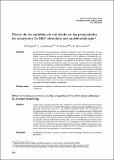Por favor, use este identificador para citar o enlazar a este item:
http://hdl.handle.net/10261/21152COMPARTIR / EXPORTAR:
 SHARE SHARE
 CORE
BASE CORE
BASE
|
|
| Visualizar otros formatos: MARC | Dublin Core | RDF | ORE | MODS | METS | DIDL | DATACITE | |

| Campo DC | Valor | Lengua/Idioma |
|---|---|---|
| dc.contributor.author | López Valero, Manuela | - |
| dc.contributor.author | Jiménez, José Antonio | - |
| dc.contributor.author | Ruano, Oscar Antonio | - |
| dc.contributor.author | Benavente, R. | - |
| dc.date.accessioned | 2010-02-16T11:45:21Z | - |
| dc.date.available | 2010-02-16T11:45:21Z | - |
| dc.date.issued | 2006-10-30 | - |
| dc.identifier.citation | Revista de Metalurgia 42(5): 324-333 (2006) | en_US |
| dc.identifier.issn | 0034-8570 | - |
| dc.identifier.uri | http://hdl.handle.net/10261/21152 | - |
| dc.description | 10 páginas, 2 tablas, 8 figuras. | en_US |
| dc.description.abstract | [ES] En este trabajo se han preparado materiales compuestos base cobre, reforzados con una dispersión homogénea de 0,5 y 1% (vol.) de partículas muy finas de carburo de niobio, mediante el proceso de molienda mecánica durante 8 y 24 h y utilizando velocidades de rotación de 153 y 300 rpm. La consolidación de las partículas reforzadas obtenidas, se realizó mediante compactación uniaxial aplicando una presión de 90 MPa en caliente a 923K durante 2 h, bajo atmósfera protectora de argón. La adecuada combinación de propiedades obtenidas en esta aleación, conductividad eléctrica y propiedades mecánicas, frente a otras aleaciones base cobre similares estudiadas, se debe a la dureza y suficiente estabilidad térmica del carburo de niobio que provoca un mayor refinamiento del tamaño de partícula de cobre con un reforzamiento de la aleación. Se observó una menor fragilización y mayor conductividad eléctrica de esta aleación, como consecuencia de la menor cantidad de impurezas (hierro, cromo, carbono y oxígeno) incorporadas durante la molienda de baja energía. Mediante microscopía electrónica de barrido, de transmisión y difracción de rayos X se demuestra, además, que se produce un reforzamiento microestructural adicional por la precipitación de las impurezas nanométricas. | en_US |
| dc.description.abstract | [EN] Copper-base composite materials were obtained by reinforcing with homogeneous dispersions of 0.5 and 1% vol. of very fine NbC particles, through mechanical milling process in a planetary mill during 8 and 24 h at two different rotational speeds. The consolidation of the alloyed reinforced particles was achieved through a hot uniaxial pressing at 923K under 90 MPa during 2 h under a protective argon atmosphere. Factors to the suitable combination of electrical conductivity and mechanical properties attained are the hardness and good thermal stability of the niobium carbide which affords further refinement in the size of copper particles and the reinforcement of the alloy. A lower embrittlement and higher electrical conductivity of this alloy was observed, as a consequence of the smaller amount of impurities (Fe, Cr, C and O) incorporated during the lower-energy milling. Scanning and transmission electron microscopy and X-ray diffraction show an additional strengthening of the grain substructure by precipitation of nanometer-size impurities. | en_US |
| dc.description.sponsorship | Los autores agradecen el soporte económico otorgado al proyecto de cooperación internacional CONICYTCSIC Nº 2002-3-141 y al proyecto MAT 97/07/00 del CENIM, CSIC de España. | en_US |
| dc.format.extent | 2939965 bytes | - |
| dc.format.mimetype | application/pdf | - |
| dc.language.iso | spa | en_US |
| dc.publisher | Consejo Superior de Investigaciones Científicas (España) | en_US |
| dc.rights | openAccess | en_US |
| dc.subject | Reforzamiento materiales compuestos base cobre | en_US |
| dc.subject | Pulvimetalurgia | en_US |
| dc.subject | Propiedades mecánicas y eléctricas | en_US |
| dc.subject | Strengthening of copper composite materials | en_US |
| dc.subject | Powder metallurgy | en_US |
| dc.subject | Mechanical and electrical properties | en_US |
| dc.title | Efecto de las variables de molienda en las propiedades de aleaciones Cu-NbC obtenidas por pulvimetalurgia | en_US |
| dc.title.alternative | Effect of milling conditions on the properties of Cu-NbC alloys obtained by powder metallurgy | en_US |
| dc.type | artículo | en_US |
| dc.identifier.doi | 10.3989/revmetalm.2006.v42.i5.30 | - |
| dc.description.peerreviewed | Peer reviewed | en_US |
| dc.relation.publisherversion | http://dx.doi.org/10.3989/revmetalm.2006.v42.i5.30 | en_US |
| dc.identifier.e-issn | 1988-4222 | - |
| dc.type.coar | http://purl.org/coar/resource_type/c_6501 | es_ES |
| item.openairecristype | http://purl.org/coar/resource_type/c_18cf | - |
| item.fulltext | With Fulltext | - |
| item.cerifentitytype | Publications | - |
| item.openairetype | artículo | - |
| item.languageiso639-1 | es | - |
| item.grantfulltext | open | - |
| Aparece en las colecciones: | (CENIM) Artículos | |
Ficheros en este ítem:
| Fichero | Descripción | Tamaño | Formato | |
|---|---|---|---|---|
| 107.pdf | 2,87 MB | Adobe PDF |  Visualizar/Abrir |
CORE Recommender
SCOPUSTM
Citations
1
checked on 12-abr-2024
Page view(s)
569
checked on 17-abr-2024
Download(s)
254
checked on 17-abr-2024
Google ScholarTM
Check
Altmetric
Altmetric
NOTA: Los ítems de Digital.CSIC están protegidos por copyright, con todos los derechos reservados, a menos que se indique lo contrario.
